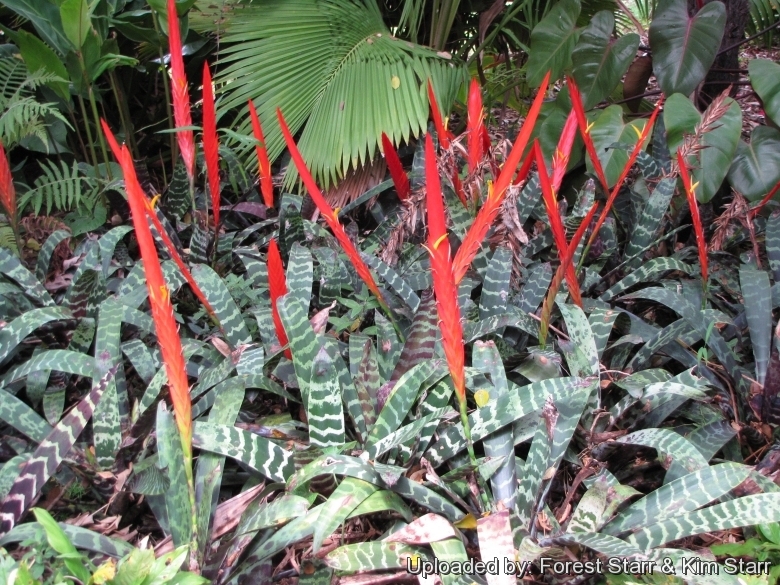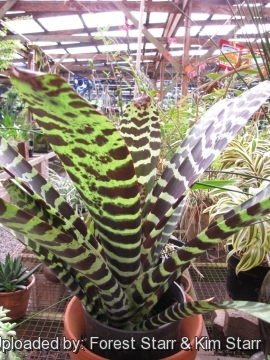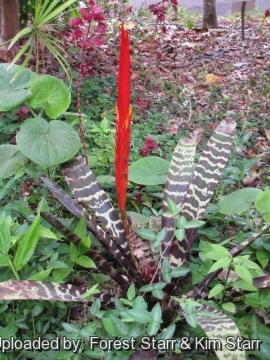Accepted Scientific Name: Vriesea splendens (Brongn.) Lem.
Fl. Serres Jard. Eur. 6: 162 (1851) Van Houtte

Tillandsia splendens (Vriesea splendens) Photo by: Forest Starr & Kim Starr
Flowering habit at Enchanting Floral Gardens of Kula, Maui, Hawaii (USA). August 03, 2010.
Origin and Habitat: Native to Eastern Venezuela,Trinidad, Surinam and French Guiana.
Altitude: Vriesea splendensSN|28798]]SN|28798]] is typically found at an altitude of 0 to 700 meters.
Habitat: In the wild it inhabits in subtropical or tropical moist, dense forests and mountain savanna forest as either an epiphytic (tree dwelling), saxicole (rock dwelling) or terrestrial (ground dwelling) plant. It has adapted to such a wide range of environments in habitat that it also readily adapts in cultivation to be grown in shadehouses, greenhouses and the indoors.
Ecology: Each plant establishes its’ own micro habitat, with the gradual build up of humus, mosses and lichens around the root system providing a store of water and nutrients in addition to the reserves held in the copious leaf bases and vases. Hummingbirds are the key pollinators of Vriesea.
Synonyms:
See all synonyms of Vriesea splendens
back
Accepted name in llifle Database:Vriesea splendens (Brongn.) Lem.Fl. Serres Jard. Eur. 6: 162 (1851)Synonymy: 16
back
Common Names include:
ENGLISH: Flaming Sword, Flaming Sword Bromeliad, Painted Feather
ARABIC ( لعربية ): فريسية لامعة
CHINESE (中文): 虎紋鳳梨
SWEDISH (Svenska): Papegojstjärt
Description: Vriesea splendensSN|28798]]SN|28798]] is a species of flowering plant in the bromeliad family, subfamily Tillandsioideae that features smooth-margined green foliage with prominent dark brown bands across them. The bright red inflorescence in a flattened spike will develop yellow tubular flowers that last only one day each. These plants were introduced to Europe in 1840 following New World exploration and are now among the most widely grown broms. There are many named varieties, which may vary in leaf variegation and the shade of the flowering spike.
Rosette: Funnelform up to 90 m wide with relatively few leaves congregate at the base to form a broad funnel that pools water and forest debris for nourishment. This physique enables them to store water for a certain period. Water and nutrients are preferably absorbed through the leaves since the roots primarily serve as adhesion organs. After flowering, the rosette will degrade and eventually die, allowing the young pup offshoots to replace it.
Leaves: 20-75 cm long, up to 6,5 cm wide, stiff, strap-like, ligulate or lance-shaped, often arching, horizontally striped with light grey-green bands and dark-green, brown or deep purple-black bands. The leaves have smooth margins and may have colourful bracts at the leaf bases.
**Inforescence: The inflorescence is a simple, unbranched, short-stalked, many flowered spike, erect, strongly flattened, narrowly lanceolate or oblong, that rises as a bright scarlet sword up to 55 cm tall and 6 cm wide. The spikes are comprised of distichous (in 2 rows) imbricate (overlapping like tiles or shingles on a roof) , keeled bracts (petal-like leaves) that support little, tubular flowers of bright yellow and short-lived, the bracts are bright red or orange and last for months. Usually bromeliads do not self pollinate, but there are exceptions to the rule. Such is the case of Vriesea splendensSN|28798]]SN|28798]].
Blooming season: It takes several of years before plants are mature enough to produce flowers, but once mature they develops a flower spike in mainly the summer and may last for many months.
Fruits: Inconspicuous capsule
Seeds:*** With basal coma of hairs.
Subspecies, varieties, forms and cultivars of plants belonging to the Vriesea splendens gruop
Bibliography: Major references and further lectures
1) Forest & Kim Starr “Vriesea splendens (Flaming sword)”. Plants of Hawaii. <http://www.starrenvironmental.com>. Downloaded on 20 August 2014.
3) Wikipedia contributors. "Vriesea splendens." Wikipedia, The Free Encyclopedia. Wikipedia, The Free Encyclopedia, 6 Jul. 2014. Web. 18 Sep. 2014.
3) David H. Benzing “Bromeliaceae: Profile of an Adaptive Radiation” Cambridge University Press, 06/Apr/2000
4) Klaus Kubitzki, H. Huber “Flowering Plants. Monocotyledons: Alismatanae and Commelinanae (except Gramineae)” Springer Science & Business Media, 27/Aug/1998
5) Hokche, O., Berry, P.E. & Huber, O. (eds.) (2008). "Nuevo Catálogo de la Flora Vascular de Venezuela" 1-859. Fundación Instituto Botánico de Venezuela.
6) Funk, V. A., P. E. Berry, S. Alexander, T. H. Hollowell & C. L. Kelloff. 2007. "Checklist of the Plants of the Guiana Shield (Venezuela: Amazonas, Bolivar, Delta Amacuro; Guyana, Surinam, French Guiana)." Contributions from the United States National Herbarium 55: 1–584
7) Smith, L.B. & R. J. Downs. 1977. "Tillandsioideae (Bromeliaceae)" Part II. Flora Neotropica, Monograph 14(2): 663–1492
8) Barbara Pleasant “The Complete Houseplant Survival Manual: Essential Gardening Know-how for Keeping (Not Killing!) More Than 160 Indoor Plants“ Storey Publishing, 30/Oct/2012
9) Stuart Max Walters “European Garden Flora: A Manual for the Identification of Plants Cultivated in Europe, Both Out-of-Doors and Under Glass” Cambridge University Press, 15/Mar/1984
10) Umberto Quattrocchi “CRC World Dictionary of Plant Names: Common Names, Scientific Names, Eponyms. Synonyms, and Etymology” CRC Press, 22/Nov/1999
11) Christopher Brickell “RHS Encyclopedia of Plants and Flowers” Dorling Kindersley Ltd, 01/Sep/2010
 Habit at Sacred Garden of Maliko, Maui, Hawaii (USA). January 24, 2011. (Vriesea splendens) Photo by: Forest Starr & Kim Starr
Habit at Sacred Garden of Maliko, Maui, Hawaii (USA). January 24, 2011. (Vriesea splendens) Photo by: Forest Starr & Kim Starr Flowering habit at Enchanting Floral Gardens of Kula, Maui, Hawaii (USA). August 03, 2010. (Vriesea splendens) Photo by: Forest Starr & Kim Starr
Flowering habit at Enchanting Floral Gardens of Kula, Maui, Hawaii (USA). August 03, 2010. (Vriesea splendens) Photo by: Forest Starr & Kim Starr Habit at Garden of Eden Keanae, Maui, Hawaii (USA). March 30, 2011. (Vriesea splendens) Photo by: Forest Starr & Kim Starr
Habit at Garden of Eden Keanae, Maui, Hawaii (USA). March 30, 2011. (Vriesea splendens) Photo by: Forest Starr & Kim StarrSend a photo of this plant.The gallery now contains thousands of pictures, however it is possible to do even more. We are, of course, seeking photos of species not yet shown in the gallery but not only that, we are also looking for better pictures than those already present.
Read More... Cultivation and Propagation: Vriesea splendensSN|28798]]SN|28798]] is a species of flowering plant in the bromeliad family, subfamily Tillandsioideae that features smooth-margined green foliage with prominent dark brown bands across them. The bright red inflorescence in a flattened spike will develop yellow tubular flowers that last only one day each. These plants were introduced to Europe in 1840 following New World exploration and are now among the most widely grown broms. There are many named varieties, which may vary in leaf variegation and the shade of the flowering spike.
Rosette: Funnelform up to 90 m wide with relatively few leaves congregate at the base to form a broad funnel that pools water and forest debris for nourishment. This physique enables them to store water for a certain period. Water and nutrients are preferably absorbed through the leaves since the roots primarily serve as adhesion organs. After flowering, the rosette will degrade and eventually die, allowing the young pup offshoots to replace it.
Leaves: 20-75 cm long, up to 6,5 cm wide, stiff, strap-like, ligulate or lance-shaped, often arching, horizontally striped with light grey-green bands and dark-green, brown or deep purple-black bands. The leaves have smooth margins and may have colourful bracts at the leaf bases.
**Inforescence: The inflorescence is a simple, unbranched, short-stalked, many flowered spike, erect, strongly flattened, narrowly lanceolate or oblong, that rises as a bright scarlet sword up to 55 cm tall and 6 cm wide. The spikes are comprised of distichous (in 2 rows) imbricate (overlapping like tiles or shingles on a roof) , keeled bracts (petal-like leaves) that support little, tubular flowers of bright yellow and short-lived, the bracts are bright red or orange and last for months. Usually bromeliads do not self pollinate, but there are exceptions to the rule. Such is the case of Vriesea splendensSN|28798]]SN|28798]].
Blooming season: It takes several of years before plants are mature enough to produce flowers, but once mature they develops a flower spike in mainly the summer and may last for many months.
Fruits: Inconspicuous capsule
Seeds:*** With basal coma of hairs.












